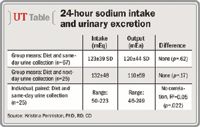Article
24-hour urinary sodium excretion's utility questioned
Author(s):
Although 24-hour urinary sodium excretion is considered the gold standard for assessing a person's dietary sodium intake, findings of a study call this practice into question.
Atlanta-Although 24-hour urinary sodium excretion is considered the gold standard for assessing a person's dietary sodium intake, findings of a study presented at the AUA annual meeting in Atlanta call this practice into question.
As reported by first author Kristina Penniston, PhD, RD, CD, the results showed significant inter- and intra-individual variability in 24-hour sodium excretion as a percentage of daily intake, and while there was good correlation between sodium intake and excretion on a population level, the latter data overestimated the accuracy of the urinalysis as a surrogate for individual sodium intake.

Sodium intake was assessed from weighed multiple-day diet records and compared with sodium excreted in concomitant 24-hour urine collections as well as with next-day collections to account for individual variation in fluid and electrolyte retention and non-renal fluid losses. In analyses based on 67 evaluable, paired datapoints for same-day diet and urine collection, mean urinary sodium accounted for 98% of sodium intake. The correlation was lower in the analysis based on next-day urine collections, which was done using data from 25 paired observations, but the urinary sodium still accounted for 83% of intake.
However, when data were analyzed at the individual level, there was no correlation between sodium intake and excretion comparing either same-day diet and urinary excretion data or next-day urinary excretion data. Across 25 paired observations for the same-day analysis, the amount of sodium excreted as a function of reported intake averaged 108%. However, it ranged from 28% to 316%. The correlation was somewhat better using data from next-day urine collections, but still not high, reported Dr. Penniston, who worked on the study with Stephen Y. Nakada, MD, and Katrina F. Wojciechowski, RD.
"Overall, the excreted amount of sodium was within the expected range of 90% to 110% of intake for only 18% of the observations. Age and body mass index did not explain the difference between dietary sodium intake and excretion," she said.
"We considered that the accuracy of our participants in keeping food records might be questionable," Dr. Penniston added, but she noted that results of a post hoc analysis of data from a previous in-hospital study where sodium intake was known and where 24-hour urine collections were supervised by hospital personnel also showed no correlation between intake and excretion on an individual level.
In conclusion, Dr. Penniston suggested that urologists use the 24-hour urinary excretion of sodium as only one of several measures to assess dietary sodium intake and its effect on renal calcium excretion and noted that it does not replace the need for a thorough nutritional assessment of individual patients.















